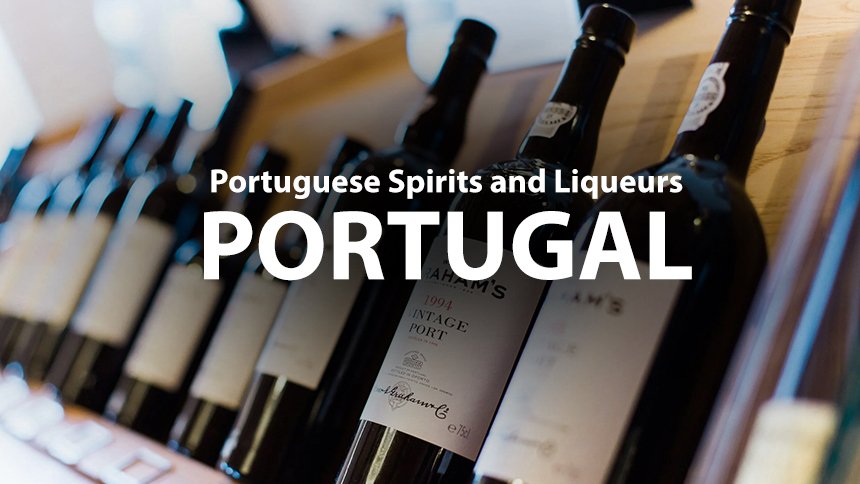In this guide to the top 12 Portuguese spirits and liqueurs, discover the finest sips of Portugal that every connoisseur should know about. Each flavours offer a taste of the country’s cultural and historical heritage, making these Portuguese spirits and liqueurs much more than just beverages.
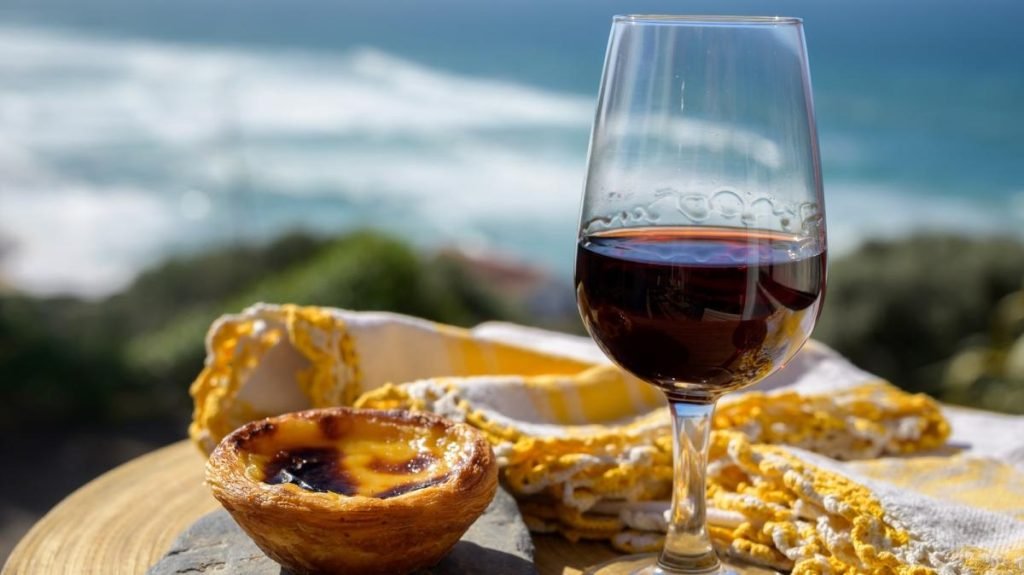
This delectable collection of drinks produced by monks in the nineteenth century or a liqueurs that has become a mainstay in Portuguese celebrations offers an intriguing peek into Portugal’s illustrious past and dynamic present. From the sweet and tangy Ginja to the powerful and earthy Medronho, these Portuguese spirits and liqueurs appeal to a wide spectrum of palates and tastes.
If you’re planning a trip to Portugal or looking to try new tastes from the comfort of your home, explore these top 12 Portuguese spirits and liqueurs uncovering the secrets behind each drink, learn about their unique production processes, and discover the best ways to enjoy.
Portuguese Spirits and Liqueurs
1. Ginja (Ginjinha)
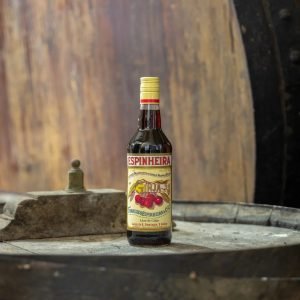
Ginja (sometimes spelled Ginjinha) is a Portuguese liqueur made from sour cherries, alcohol, sugar, and spices such as cinnamon and clove. It originated in Lisbon and has since become a popular drink across the country. Many bars in Lisbon sell ginja, including historic establishments such as Ginja Sem Rival (established in 1890) and A Ginjinha Espinheira (founded in 1840 by a Galician monk).Ginja is renowned for its beautiful ruby color and sweet, tart flavor. It’s brilliant crimson and thick, with a smooth, warming flavor.
Ginja is typically served as a shot with a piece of fruit at the bottom of the glass, and it is traditionally coupled with two cherries. It can be consumed as an aperitif or digestif, and some people believe it goes well with chocolate, sardines, or vanilla ice cream. Ginja can be enjoyed straight, in a shot, or combined with soda for a refreshing twist of Portuguese spirits and liqueurs.
2. Licor Beirão

Licor Beirão is a popular Portuguese liqueur made with herbs and spices. This golden-brown liqueur has a nice balance of sweet and bitter flavors, with traces of cinnamon, anise, and rosemary.
Licor Beirão was founded in 1929 in the Quinta do Meiral estate in the Lousa highlands of Portugal, and is named after the estate. It is a sweet, 22% ABV liqueur prepared with a secret recipe of 13 aromatic seeds, herbs, and spices that have been double distilled. The liqueur was established by local pharmacist José Carranca Redondo, and the company has been family-owned ever since. Beirão gained popularity as “Portugal’s liquor” after winning a gold medal at the 2nd Beiratilde;o Congress in 1929.
Serve Licor Beirão over ice, as a shot, or in cocktails like the Beirão Mojito. It’s a versatile drink of Portuguese spirits and liqueurs that pairs well with various mixers.
3. Aguardente

Aguardente, which translates to “firewater,” is a strong Portuguese alcohol made from grapes. It is comparable to brandy and differs according to area. It is recognized for its intense, spicy flavor and high alcohol level. The flavor can vary from pleasant and fruity to harsh and powerful, depending on the age and method of manufacture.
In Portugal, aguardente is primarily manufactured from grape pomace, known as bagaço de uva. This contains grape skins, seeds, and stems left over from winemaking, which are fermented to convert sugars to alcohol. Aguardente is often sipped plain in modest quantities, although it can also be mixed into cocktails or used as a foundation for other Portuguese spirits and liqueurs.
4. Porto (Port Wine)
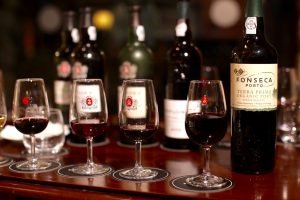
Port wine, or simply port, is a fortified wine produced in Portugal’s Douro Valley. Porto is available in a variety of types, including Ruby, Tawny, and Vintage, with each having distinct flavor profiles ranging from sweet and fruity to rich and nutty.
It is prepared using a combination of indigenous grapes, including Tinto Roriz, Tinto Cao, Tinto Barrocca, Touriga Nacional, and Touriga Francesca for red ports, and Malvasia and Rabigato for white ports. Port wines have an average alcohol concentration of 16-20%, which is 4-6% more than regular wines. Sweet red port is commonly served with dessert, but it also pairs well with cheeses, chocolates, and nuts.
5. Madeira Wine

Madeira wine, a fortified wine famed for its longevity and complex aromas, has been made on the volcanic island of Madeira in the Atlantic Ocean for over 500 years. A variety of variables contribute to the wine’s distinct taste, including the volcanic soil of the island, the grapes utilized, and the maturing procedure
Tinta Negra, Terrantez, Bastardo, Malvasia, Sercial, Verdelho, and Bual de Madeira are some of the grape varieties used to make Madeira wines. During fermentation, these wines are fortified with brandy or neutral alcohol, increasing the alcoholic content to 17.5% to 21%.
Madeira ranges from dry to sweet, with notes of caramel, almonds, and dried fruits, frequently accented by a unique smoky character. Madeira is ideal for cooking, particularly in sauces and sweets.
6. Amarguinha

Amarguinha is a classic Portuguese liqueur from the Algarve region prepared from bitter almonds. This liqueur is sweet with a distinct almond flavor and a somewhat bitter aftertaste, making it both unique and unforgettable. It’s pale yellow in color, with a thick, full-bodied syrup with a strong aroma of spiced almonds, citrus fruit, and bear claw pastry. Amarguinha can be served chilled or over ice, usually with a splash of lemon juice. It’s also an excellent way to add Portuguese spirits and liqueurs to coffee or dessert.
7. Medronho
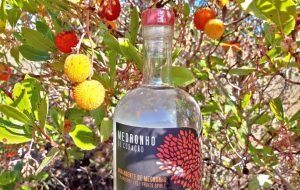
Medronho, also known as aguardente de medronhos or firewater, is a clear, distilled fruit brandy made from the fruit of the strawberry tree (Arbutus unedo), which is most commonly found in the Algarve and Alentejo areas. The strawberry fruit is sweet but bland when eaten fresh, but it may be utilized in a variety of goods, including jams, jellies, wine, and cakes.
Medronho is a potent spirit with an alcohol concentration of approximately 50% that can burn your throat and stomach. It has a robust, earthy flavor and high alcohol concentration. It can be quite potent, sometimes compared to moonshine. As a digestive, it is often served pure and at room temperature after a meal.
Medronho is typically enjoyed neat, however it should be sipped slowly to appreciate its powerful taste.
8. Bagaceira

Bagaceira, also known as aguardente bagaceira, is a Portuguese pomace brandy prepared from residual grape skins and stems, or pomace from winemaking, and is similar to Italian grappa. The pomace is distilled in copper alambiques, yielding a spirit with an alcohol level of 35-54% by volume at 20°C. Besides all popular Portuguese spirits and liqueurs, Bagaceira is Portugal’s national brandy, which is often prepared at home to reach a greater alcohol percentage.
Bagaceira can be savored on its own or in cocktails such as café com cheirinho, which combines espresso, liqueur coffee, and a hint of fragrance. It can also be served cold in tiny glasses after meals as a digestif.
9. Licor de Merda
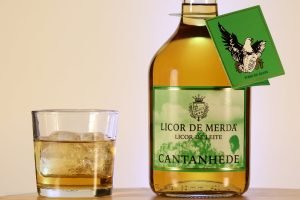
Despite its strange name, which translates as “Liqueur of Sh*t,” Licor de Merda is a famous Portuguese liqueur prepared from a combination of herbs and spices. It is a classic Portuguese liqueur composed of milk, vanilla, cocoa, cinnamon, sugar, and citrus that was invented in 1974 to celebrate some of the authorities who ruled Portugal during a tough period. It is described as rich, smooth, pleasant, and easy to consume.
The liqueur is made by hand and comes in 700 mL bottles with a 20% volume. It can be eaten at the conclusion of a meal or during a night out. The liqueur has a sweet, herbaceous flavor and a smooth finish. Its unusual moniker adds to its charm and attractiveness. Licor de Merda can be enjoyed straight, over ice, or mixed into cocktails. It’s frequently used as a conversation starter at events.
10. Licor de Poejo
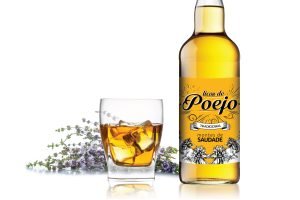
Licor de Poejo is a traditional, homemade liqueur from Portugal’s Alentejo area, created with pennyroyal and Alentejo brandy. The entire soul of Alentejo in a single liquor. With a distinct and identifiable flavor, iIt is dye and preservative-free. The liqueur is intended to preserve the flavors and natural colors of the plants used. It can be served extremely cold or with an ice cube.
This liqueur has a pleasant, minty flavor with a hint of herbal bitterness, making it unique among Portuguese spirits and liqueurs. Licor de Poejo can be consumed as an aperitif or digestive. It’s also great for drinks.
11. Favaios Moscatel
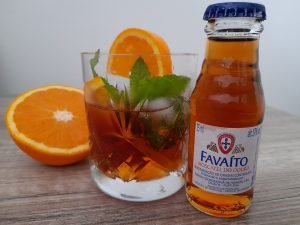
Favaios Moscatel is a sweet fortified white wine created from Portuguese Muscat grapes grown at Adega de Favaios in the Douro area. This wine is creamy and sweet, with notes of honey, orange blossom, and apricot. It’s silky and fragrant and has a golden, clean, and bright appearance.
Favaios Moscatel is designed for immediate consumption, but its attributes can last for several years after bottling. It is a delicious dessert or aperitif wine that pairs well with pastries, fruits, and cheeses.
12. Grogue

Grogue is composed entirely of sugarcane. It is a traditional Portuguese drink from Cape Verde created from distilled sugarcane juice. Grogue is powerful and clear, with a forceful, slightly sweet flavor. It is often compared to rum, yet it has unique properties.
During the distillation process, the entire sugar-cane plant is placed in a trapiche, which presses it between two spinning barrels, reducing it to a liquid that can be converted into alcohol. Each has its own distinct taste and alcohol concentration, which is often over 60%. Some have reached up to 80%, while others remain cautious at 50%.
Grogue is a Cape Verdean celebration Portuguese spirits and liqueurs, typically drank neat or with a touch of lime.



